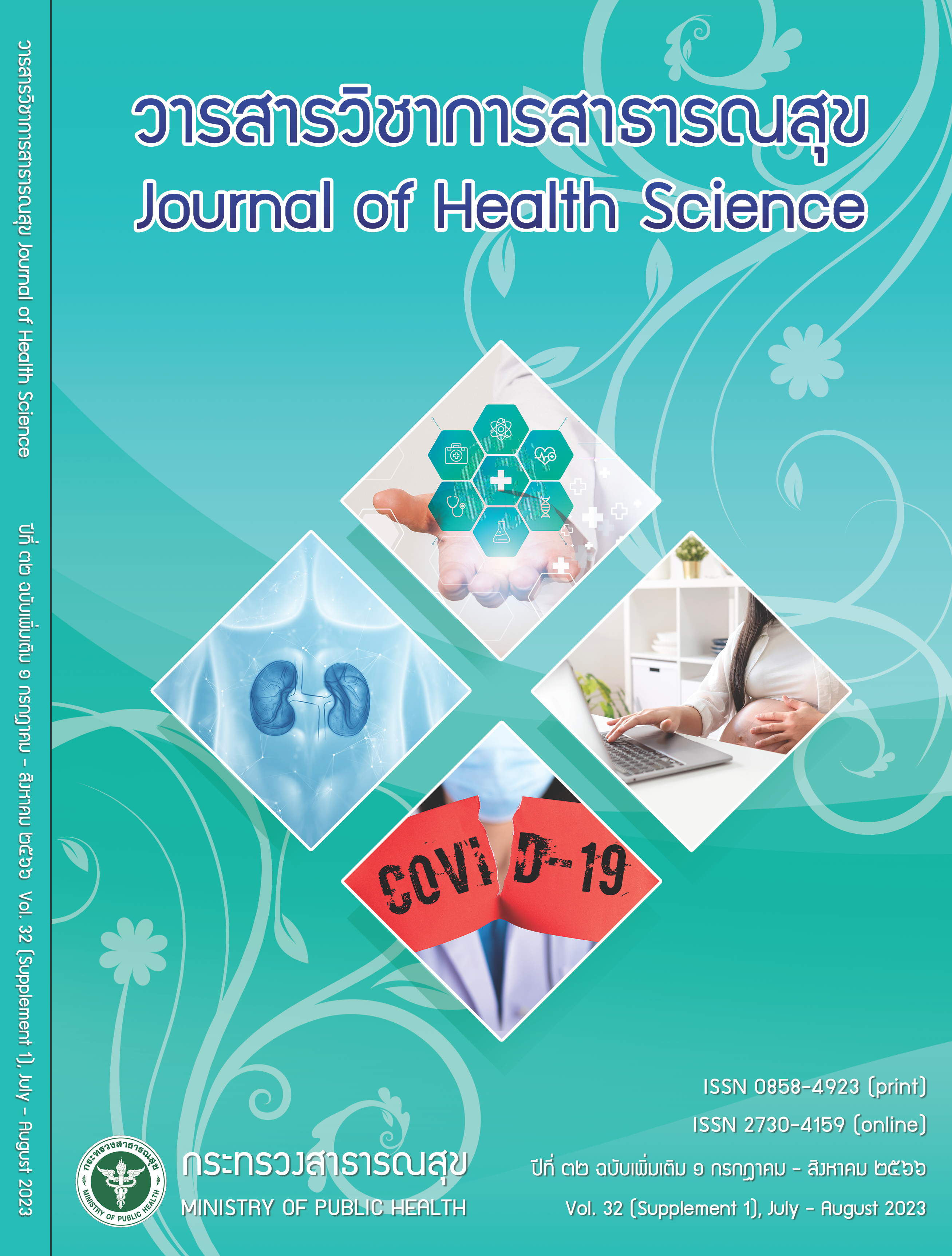การศึกษาเปรียบเทียบความสำเร็จของการรักษาโรคนิ่วที่ท่อไตส่วนกลางและส่วนปลายระหว่างการยิงสลายนิ่วและการผ่าตัดส่องกล้องนิ่วที่ท่อไตในโรงพยาบาลหนองคาย
คำสำคัญ:
นิ่วท่อไตส่วนกลางและส่วนล่าง, ยิงสลายนิ่ว, ผ่าตัดส่องกล้องท่อไตบทคัดย่อ
การรักษานิ่วที่ท่อไตมีหลายวิธี ได้แก่ การให้ยาบรรเทาอาการร่วมกับติดตามอาการ การให้ยาช่วยให้นิ่วหลุด การยิงสลายนิ่ว (extracorporeal shockwave lithotripsy; ESWL) การผ่าตัดส่องกล้องนิ่วที่ท่อไต (ureteroscopic lithotripsy; URSL) และการผ่าตัดแบบเปิด การเลือกวิธีในการรักษาขึ้นอยู่กับหลายปัจจัย การศึกษานี้มีวัตถุประสงค์ เพื่อเปรียบเทียบอัตราความสำเร็จของการรักษาโรคนิ่วที่ท่อไตส่วนกลางและส่วนปลายระหว่างวิธี ESWL และ URSL เป็นการศึกษาวิจัยเชิงพรรณนาในผู้ป่ วยนิ่วที่ท่อไตส่วนกลางและส่วนปลายในโรงพยาบาลหนองคาย ตั้งแต่ปี พ.ศ. 2558-2563 จำนวน 196 ราย โดย 139 รายได้รับการรักษาด้วยวิธี URSL และ 57 รายได้รับการรักษาด้วยวิธี ESWL โดยที่อัตราความสำเร็จคิดจากอัตราการที่นิ่วหลุดหมดหลังการรักษา 4-6 สัปดาห์ โดยเปรียบเทียบผลการ รักษาของ 2 วิธีได้แก่ ข้อมูลพื้นฐานผู้ป่ วย ข้อมูลคุณลักษณะของนิ่ว อัตราความสำเร็จนิ่วหลุดหมดหลังรักษา การ รักษาซ้ำ การรักษาด้วยวิธีการอื่น และภาวะแทรกซ้อนที่สำคัญของการรักษา วิเคราะห์ข้อมูลโดยใช้สถิติ independent sample T-test, Chi-square test หรือ Fisher’s exact test ผลการศึกษาพบว่าข้อมูลพื้นฐานทั้ง 2 กลุ่ม เช่น อายุ เพศ โรคประจำตัว ดัชนีมวลกาย ค่าการทำงานของไต และข้อมูลคุณลักษณะของนิ่วไม่แตกต่างอย่างมีนัยสำคัญทางสถิติ กลุ่มที่ได้รับการรักษาด้วยวิธี URSL มีอัตราความสำเร็จที่นิ่วหลุดหมดในครั้งแรกมากกว่ากลุ่มที่รักษาด้วยวิธี ESWL (ร้อยละ 91.37 และ 41.37 ตามลำดับ) อย่างมีนัยสำคัญทางสถิติ (p<0.05) ในขณะที่กลุ่มที่ได้รับการรักษาด้วยวิธี ESWL มีอัตราการรักษาซ้ำมากกว่าวิธี URSL (ร้อยละ 35.05 และ 1.44 ตามลำดับ) อย่างมีนัยสำคัญทางสถิติ (p<0.05) แต่พบว่าไม่มีความแตกต่างอย่างมีนัยสำคัญทางสถิติของอัตราความสำเร็จที่นิ่วหลุดหมดหลังรักษาซ้ำครั้ง ทีสอง (URSL ่ ร้อยละ 91.37, ESWL ร้อยละ 82.46) และภาวะแทรกซ้อนระหว่างการรักษา (URSL ร้อยละ 1.43, ESWL ร้อยละ 0.00) แต่ค่าเฉลี่ยระยะเวลานอนโรงพยาบาลของกลุ่ม ESWL 0.30 วัน สั้นกว่ากลุ่มทีรักษาด้วยวิธี URSL ่ 2.81 วัน อย่างมีนัยสำคัญทางสถิติ (p<0.05) จากการศึกษาในกลุ่มย่อยที่รักษาด้วยวิธี URSL พบว่า ขนาดของนิ่วที่ น้อยกว่าเท่ากับ 10 มิลลิเมตรมีอัตราความสำเร็จทีนิ่วหลุดหมดมากกว่านิ่วที ่ มีขนาดมากว่า 10 มิลลิเมตร 4.060 เท่า ่ (95%CI=1.167–14.128) โดยสรุป การรักษานิ่วที่ท่อไตส่วนกลางและส่วนปลายด้วยวิธี URSL มีอัตราความสำเร็จ ที่นิ่วหลุดหมดในครั้งแรกมากกว่ากลุ่มทีรักษาด้วยวิธี ESWL และกลุ่มที ่ รักษาด้วยวิธี ESWL มีโอกาสต้องรักษาซ้ำมากกว่า ในขณะทีอัตราความสำเร็จทีนิ่วหลุดหมดหลังรักษาซ้ำในครั้งทีสองของกลุ่มที ่ รักษาด้วยวิธี ESWL ใกล้เคียงกับวิธี URSL
Downloads
เอกสารอ้างอิง
Türk C, Neisius A, Petřík A, Seitz C, Skolarikos A, Thomas K, et al. EAU Guidelines on urolithasis. Arnhem, the Netherlands: European Association of Urology; 2018.
Sorokin I, Mamoulakis C, Miyazawa K, Rodgers A, Talati J, Lotan Y. Epidemiology of stone disease across the world. World J Urol 2017;35(9):1301-20.
Chaimuangraj S, Leungwattanakij S, Gojaseni P. The current therapy of urinary calculi inThailand. J med Assoc Thai 2000;83:701-7.
มณฑิรา มฤคทัต, อดิศร อภิวัฒน์การุญ, ชูศักดิ์ ปริพัฒนานนท์. นิ่วทางเดินปัสสาวะในโรงพยาบาลสงขลานครินทร์. สงขลานครินทร์เวชสาร 2545;20(4):251-9.
Ibrahim AI, Shetty SD, Awad RM, Patel KP. Prognostic factors in the conservative treatment of ureteric stones. Br J Urol 1991;67(4):358-61.
El-Nahas AR, El-Assmy AM, Mansour O, Sheir KZ. A prospective multivariate analysis of factors predicting stone disintegration by extracorporeal shock wave lithotripsy: the value of high-resolution noncontrast computed tomography. Eur Urol 2007;51(6):1688-93; discussion 1693-4.
Musa AA. Use of double-J stents prior to extracorporeal shock wave lithotripsy is not beneficial: results of a prospective randomized study. Int Urol Nephrol 2008; 40(1):19-22.
Wang H, Man L, Li G, Huang G, Liu N, Wang J. Meta-analysis of stenting versus non-stenting for the treatment of ureteral stones. PLoS One 2017;12(1):e0167670.
Li K, Lin T, Zhang C, Fan X, Xu K, Bi L, et al. Optimal frequency of shock wave lithotripsy in urolithiasis treatment: a systematic review and meta-analysis of randomized controlled trials. J Urol 2013;190(4):1260- 7.
Pishchalnikov YA, Neucks JS, VonDerHaar RJ, Pishchalnikova IV, Williams JC Jr, McAteer JA. Air pockets trapped during routine coupling in dry head lithotripsy can significantly decrease the delivery of shock wave energy. J Urol 2006;176(6 Pt 1):2706-10.
Jain A, Shah TK. Effect of air bubbles in the coupling medium on efficacy of extracorporeal shock wave lithotripsy. Eur Urol 2007;51(6):1680-6; discussion 1686-7.
Aboumarzouk OM, Hasan R, Tasleem A, Mariappan M, Hutton R, Fitzpatrick J, et al. Analgesia for patients undergoing shockwave lithotripsy for urinary stones - a systematic review and meta-analysis. Int Braz J Urol 2017;43(3):394-406.
Chen K, Mi H, Xu G, Liu L, Sun X, Wang S, et al. The efficacy and safety of tamsulosin combined with extracorporeal shockwave lithotripsy for urolithiasis: a systematic review and meta-analysis of randomized controlled trials. J Endourol 2015;29(10):1166-76.
Cybulski PA, Joo H, Honey RJ. Ureteroscopy: anesthetic considerations. Urol Clin North Am 2004;31(1):43- 7.
Leijte JA, Oddens JR, Lock TM. Holmium laser lithotripsy for ureteral calculi: predictive factors for complications and success. J Endourol 2008;22(2):257-60.
Binbay M, Tepeler A, Singh A, Akman T, Tekinaslan E, Sarilar O, et al. Evaluation of pneumatic versus holmium:YAG laser lithotripsy for impacted ureteral stones. Int Urol Nephrol 2011;43(4):989-95.
Verze P, Imbimbo C, Cancelmo G, Creta M, Palmieri A, Mangiapia F, et al. Extracorporeal shockwave lithotripsy vs ureteroscopy as first-line therapy for patients with single, distal ureteric stones: a prospective randomized study. BJU Int 2010;106(11):1748-52.
Hendrikx AJ, Strijbos WE, de Knijff DW, Kums JJ, Doesburg WH, Lemmens WA. Treatment for extendedmid and distal ureteral stones: SWL or ureteroscopy? Results of a multicenter study. J Endourol 1999; 13(10):727-33.
Zeng GQ, Zhong WD, Cai YB, Dai QS, Hu JB, Wei HA. Extracorporeal shock-wave versus pneumatic ureteroscopic lithotripsy in treatment of lower ureteral calculi. Asian J Androl 2002;4(4):303-5.
Honeck P, Häcker A, Alken P, Michel MS, Knoll T. Shock wave lithotripsy versus ureteroscopy for distal ureteral calculi: a prospective study. Urol Res 2006; 34(3):190-2.
Picozzi SC, Ricci C, Gaeta M, Casellato S, Stubinski R, Bozzini G, et al. Urgent ureteroscopy as first-line treatment for ureteral stones: a meta-analysis of 681 patients. Urol Res 2012;40:581-6.
Dell’Atti L, Papa S. Ten-year experience in the management of distal ureteral stones greater than 10 mm in size. G Chir 2016;37(1):27-30.
Abdelghany M, Zaher T, El Halaby R, Osman T. Extracorporeal shock wave lithotripsy of lower ureteric stones: Outcome and criteria for success. Arab J Urol 2011; 9(1):35-9.
Wiesenthal JD, Ghiculete D, D’A Honey RJ, Pace KT. Evaluating the importance of mean stone density and skin-to-stone distance in predicting successful shock wave lithotripsy of renal and ureteric calculi. Urol Res. 2010;38(4):307-13.
ดาวน์โหลด
เผยแพร่แล้ว
วิธีการอ้างอิง
ฉบับ
บท
การอนุญาต

This work is licensed under a Creative Commons Attribution-NonCommercial-NoDerivatives 4.0 International License.







